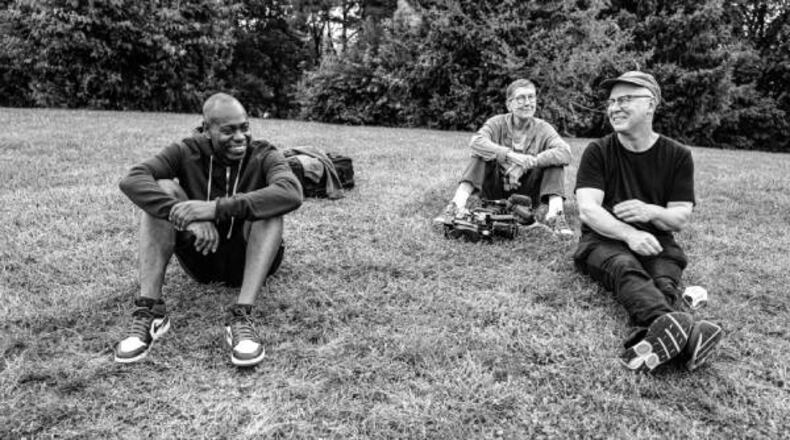With help from his famous friends, who were stringently COVID-tested upon arrival, the Emmy and Grammy Award-winning comedian’s socially distanced shows at Wirrig Pavilion quickly became the hottest ticket in town. And, as expected, the film chronicles his appealing playfulness as emcee to the hilt. “I’m a regular person, but I’m very rich,” he jokes. Despite controversy and pushback from some citizens who objected to the noise and adult language among other complaints, Chappelle and his team persevered with humor and heart until a positive COVID test within their bubble forced cancellation. Nonetheless, the over 50 shows produced reportedly brought in more than $9 million to Yellow Springs and the region.
Credit: RUSSELL FLORENCE JR
Credit: RUSSELL FLORENCE JR
The D.C. premiere, held inside the spacious Concert Hall with over 2,000 in attendance including D.C. Mayor Muriel Bowser, marked the first full -capacity event at the Kennedy Center since March 2020. Cell phones were notably silenced and sealed in Yondr pouches. The audience, all masked per D.C. mandate and temperature checked, was thoroughly engaged by the film, laughing and applauding from start to finish. In many respects, the feeling in the room was electric.
In addition to the hilarious yet topical and thought-provoking stand-up routines from Chappelle, Jon Stewart, Michelle Wolf, Chris Rock, Tiffany Hadish, Donnell Rawlings and Mo Amer among others, enjoyably kooky moments pop up out of nowhere such as singer Erykah Badu’s twirling entrance at Springfield Municipal Airport, actor Jon Hamm leading “Don’t Stop Believin’” and the sight of a lone squirrel crossing a deserted street. I was particularly delighted to see Chappelle channel his inner Kevin Bacon a la “Footloose” with help from John Mayer.
Community is the soul of the film
Laughs aside, “This Time This Place,” at its core, is an impactful story of community, a meaningful examination of what brings people together in situations of peril and uncertainty.
“This is a nightmare,” Chappelle says early in the film about the pandemic. “It tests people’s character.”
Due to Bognar and Reichert’s delicate expertise at establishing character behind the camera, the powerful footage of local protests organized by college student Julian Roberts strikes a chord, especially when the large crowd, which included Chappelle’s children, is confronted by onlookers. An especially dynamic, unforgettable scene highlights Black poet Amir Sulaiman, whose riveting, tear-jerking spoken word poem describing the “American Dream is a love song gone wrong” drew vigorous applause from the Kennedy Center audience.
Bognar and Reichert also provide an array of insightful interviews with Yellow Springs business owners commenting on the economic landscape such as Karyn Current of Current Cuisine and Dino Pallotta of Dino’s Cappuccinos. And in a definite sign of the times, the duo is able to generate drama from a Zoom meeting as pavilion owners Steve and Stacey Wirrig fight on Chappelle’s behalf for a temporary usage variance during a zoning board session overseen by Miami Township Inspector Richard Zopf.
At the same rate, the filmmakers commendably spotlight the various entertainers grateful for the chance to perform during the shutdown. In particular, Wolf, who quarantined with the Chappelle family for eight weeks, evolves into an intriguing subject as she views the pandemic as a critical turning point in her career. Having been used to working in order to avoid making big decisions (“I’m scared of my thoughts,” she jokes), it is apparent the pandemic forced her to re-evaluate who she is and what she wants her life to be.
The duo also allow Chappelle moments of poignancy such as addressing the influence of his father, an Antioch College professor, and reflecting on the impact of the summer shows and their abrupt, familiar conclusion. “That’s how you know it’s going to be important because it ended weird,” Chappelle said, with his wife, Elaine, by his side. “It’s like ‘Chappelle’s Show.’”
Remarks from the creators
“We live in Ohio in a small town and we have a neighbor — his name is Dave,” Reichert cheerfully noted in her pre-screening opening remarks. “Documentary film and comedy, yes, they’re kind of different. But it’s all about storytelling — trying to find the truth.”
“We edited and finished this movie in a year,” added Bognar, who credited the contributions of director of photography Ian Cook and editor Kevin Jones. Other main cinematographers on the film include Brittany Shyne, Erick Stoll and Cameron Henderson. Cook, Jones, Shyne, Stoll, Henderson and the entire editing team are all notable alums of Wright State University’s Motion Pictures program. “Dave said he was doing a weekend of outdoor-safe shows in a friend’s field and he asked if we would document it — and so it began.” Bognar also praised Chappelle as “our visionary friend and our great collaborator.”
The premiere was a homecoming for Chappelle, who grew up in Silver Spring, Md., and is a graduate of Washington, D.C.’s Duke Ellington School of the Arts. He also began his stand-up career in D.C. in 1987. In his brief post-screening remarks, he stressed kindness and shared his rage about the Capitol insurrection before ending in appreciation.
“Thank you for raising a giant,” he said, exiting the stage to a standing ovation.
Plans for a Dayton premiere have not been announced, but whenever it arrives it will be an absolute must-see event.
Contact this contributing writer at rflorence2@gmail.com.
STAYING WITH THE STORY
Our writer Russell Florence Jr. traveled to Washington, D.C., to be in the audience for “Dave Chappelle: This Time This Place” at the John F. Kennedy Center for the Performing Arts.
About the Author


